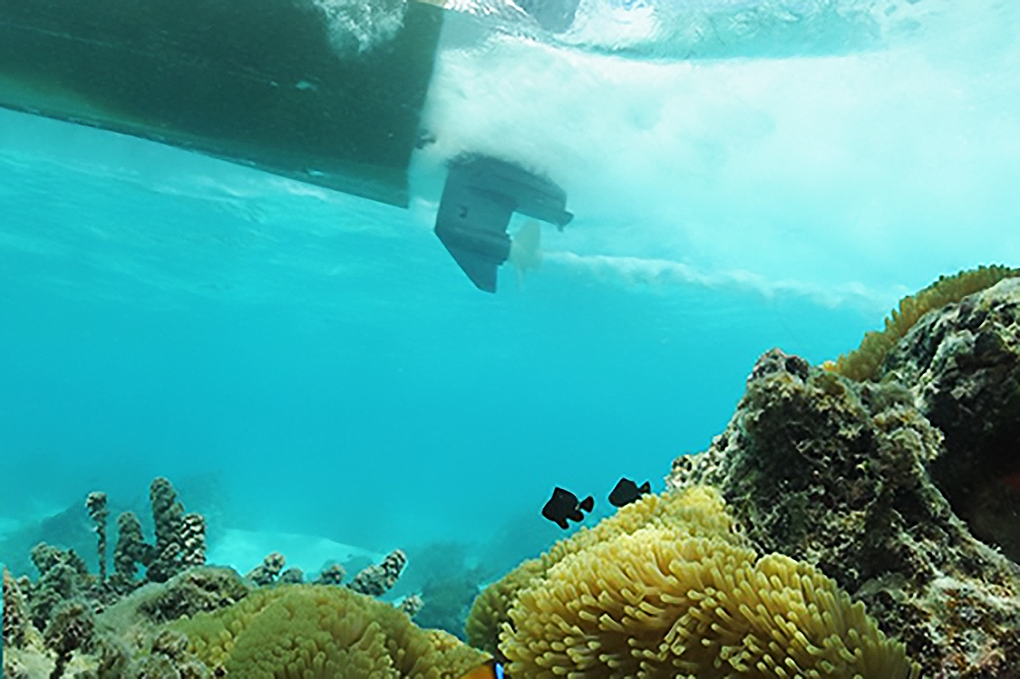
—via University of Bristol
9 April 2020
Hormonal changes caused by motorboat noise cause clownfish to hide, skip meals and attack their neighbours—putting damselfish in distress.
Working on the reefs around Moorea in French Polynesia, an international team of scientists exposed 40 pairs of Orangefin Anemonefish (Amphiprion chrysopterus) to recordings of natural reef sounds or motorboat noise for up to two days. Motorboat noise caused clownfish to hide in the protective tentacles of their host anemone, move less into open water to feed and to be more aggressive towards Domino Damselfish that also reside in the anemone.
The researchers—from France, Chile and the UK—also found that noise-affected anemonefish were unable to respond appropriately to a second stressor, likely putting them at greater risk from threats such as predators and climate change.
The study, published in the journal Environmental Pollution, found noise-exposed fish had elevated levels of the stress hormone cortisol and the reproductive hormones testosterone and 11-ketotestosterone, which corresponded with observed behavioral changes. These measurable hormones offer a window into complex behaviors and could be used to develop new noise-mitigation tools.
“The high cortisol levels after two days of exposure suggest that clownfish become chronically stressed by motorboat noise. This compromises the stress response system leaving clownfish unable to mount appropriate responses to further stressful events. If these stressful events include a predator, motorboat noise could have grave implications,” says lead author, Associate Professor Suzanne Mills at the École Pratique des Hautes Études (EPHE) PSL Université Paris, CRIOBE, France, said,

Ricardo Beldade, Associate Professor at the Pontificia Universidad Católica de Chile, said, “Clownfish defended their anemone territory aggressively during motorboat noise, which requires more energy. However, as the fish hid more and moved less to feed, even after the motorboat noise had passed, they may be unable to compensate through more foraging, with potentially detrimental impacts on growth and even survival.”

Andy Radford, Professor of Behavioural Ecology at the University of Bristol, said: “Experiments that consider behaviour of wild animals in natural conditions—as we have done in this study—are crucial if we are to understand fully the impact of anthropogenic noise. Our results highlight that behavioural changes caused by anthropogenic noise are likely underpinned by alterations in the stress response (cortisol) and certain steroid hormones.”
Dr. Sophie Nedelec, University of Exeter, said, “Now we know that hormonal responses are the mechanisms driving behavioral changes to motorboat noise, they can be a useful tool in regulation. We might be able to predict the duration and/or interval times of motorboat noise exposure that allow individuals to return to normal behavior.”
“Hormonal responses to different boat engines, propeller designs and spatial management of boating activities can be compared to reduce the impact of this globally prevalent pollutant,” says Steve Simpson, Professor of Marine Biology & Global Change at the University of Exeter. “Hormonal responses are currently under-utilised as a tool for measuring biological impacts when developing best approaches for managing the noise of the 100,000s of motorboats used around the world.”
The researchers says their findings highlight the need to control manmade noise in marine protected habitats.
Reference
‘Hormonal and behavioural effects of motorboat noise on wild coral reef fish’ by Mills, S.C.,Beldade, R., Henry, L., Laverty, D., Nedelec, S.L., Simpson, S.D., & Radford, A.N. 2020 in Environmental Pollution.
https://pubmed.ncbi.nlm.nih.gov/32443197/
DOI: 10.1016/j.envpol.2020.114250
Abstract
Anthropogenic noise is an emergent ecological pollutant in both terrestrial and aquatic habitats. Human population growth, urbanisation, resource extraction, transport and motorised recreation lead to elevated noise that affects animal behaviour and physiology, impacting individual fitness. Currently, we have a poor mechanistic understanding of the effects of anthropogenic noise, but a likely candidate is the neuroendocrine system that integrates information about environmental stressors to produce regulatory hormones; glucocorticoids (GCs) and androgens enable rapid individual phenotypic adjustments that can increase survival. Here, we carried out two field-based experiments to investigate the effects of short-term (30 min) and longer-term (48 h) motorboat-noise playback on the behaviour, GCs (cortisol) and androgens of site-attached free-living Orangefin Anemonefish (Amphiprion chrysopterus). In the short-term, anemonefish exposed to motorboat-noise playback showed both behavioural and hormonal responses: hiding and aggression increased, and distance moved out of the anemone decreased in both sexes; there were no effects on cortisol levels, but male androgen levels (11-ketotestosterone and testosterone) increased. Some behaviours showed carry-over effects from motorboat noise after it had ceased, and there was no evidence for a short-term change in response to subsequent motorboat-noise playback. Similarly, there was no evidence that longer-term exposure led to changes in response: motorboat noise had an equivalent effect on anemonefish behaviour and hormones after 48 h as on first exposure. Longer-term noise exposure led to higher levels of cortisol in both sexes and higher testosterone levels in males, and stress-responses to an additional environmental challenge in both sexes were impaired. Circulating androgen levels correlated with aggression, while cortisol levels correlated with hiding, demonstrating in a wild population that androgen/glucocorticoid pathways are plausible proximate mechanisms driving behavioural responses to anthropogenic noise. Combining functional and mechanistic studies are crucial for a full understanding of this global pollutant.




